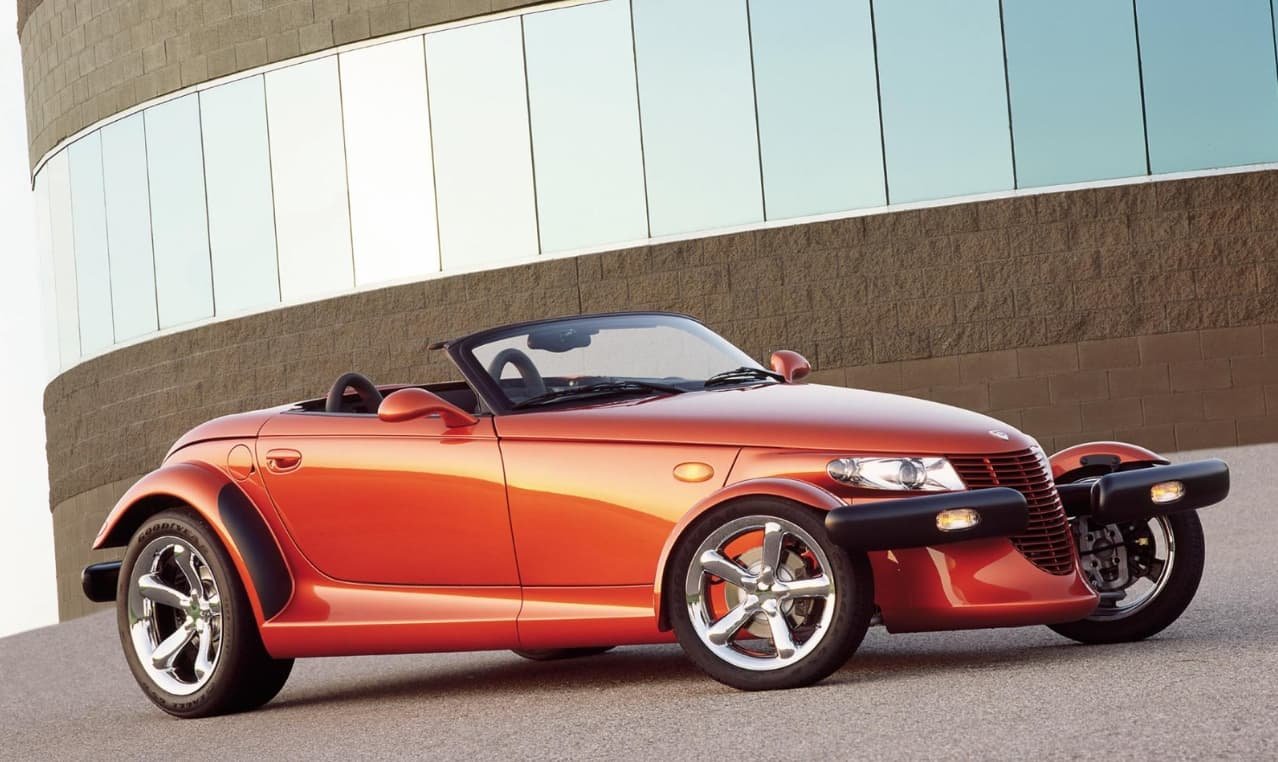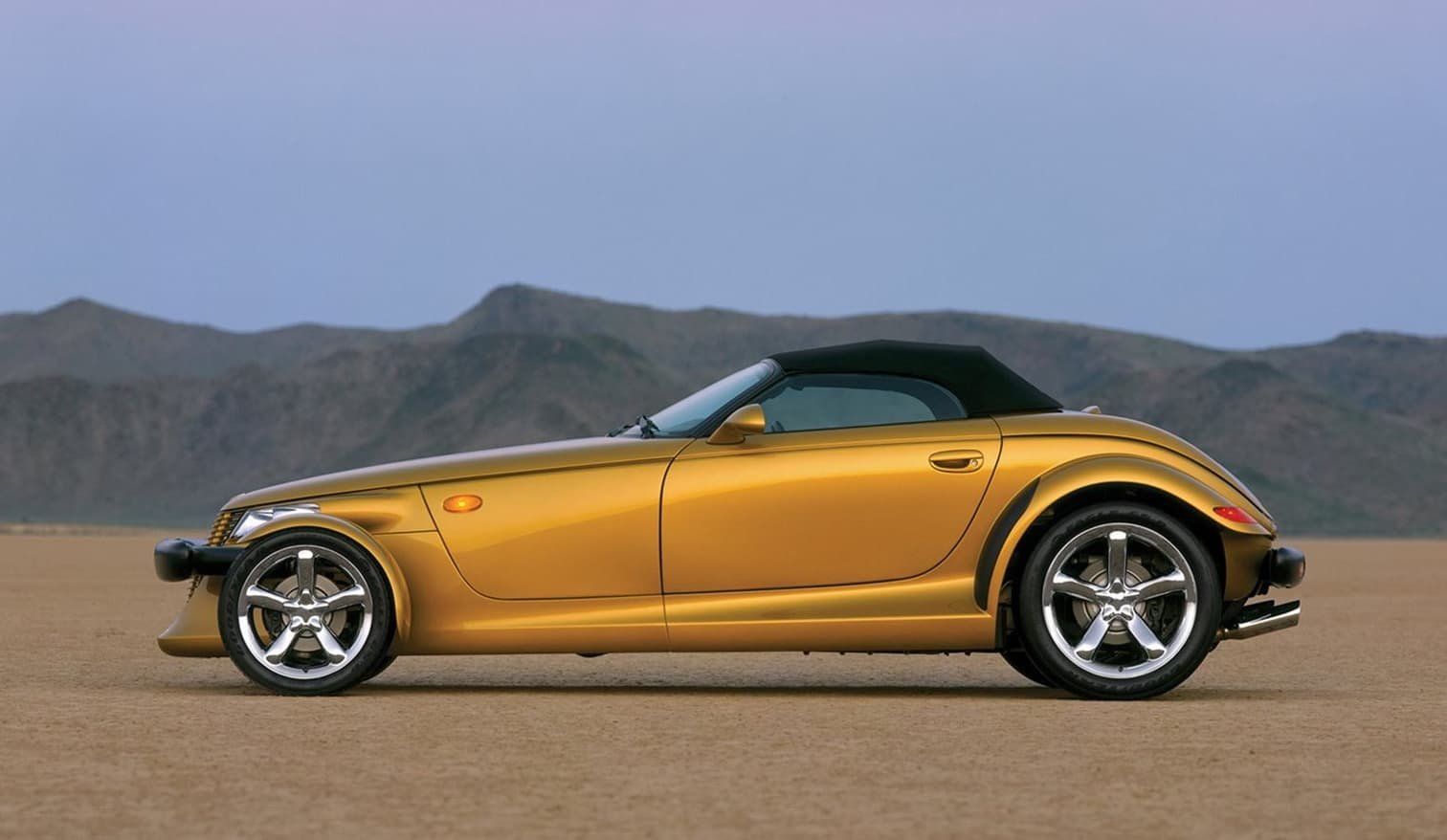Love it or hate it, the Prowler was still the most significant Plymouth in decades.
People love to dump on the Prowler. Dan Neil said it was one of the 50 worst cars of all time, and it is frequently blamed for the downfall of Plymouth. But when you consider its halo car role, not to mention the incredible obstacles put in its way by Chrysler and their dealer network, the Prowler still managed to avoid becoming an absolute debacle. The Prowler was a genuinely good effort, just a bad execution.
The Prowler debuted first in concept form in 1993, and when the production car hit dealerships in 1997, it hadn’t changed much. These dates are important, because they give us that all-important context in which the Prowler needs to be judged. The mid-Nineties were not Detroit’s finest hour. Nearly everything (trucks excluded) from the Big Three was front-wheel-drive, and badge engineering ran rampant. The Mustang GT produced 215 horsepower and the most interesting design in mainstream American cars was the 1995-1999 Buick Riviera. To be fair, this was a pretty nice design.

The supercharged 3800 V6 was also a good engine, but it doesn’t really hold a candle to the CTS-V of today. Now would also be a good time to point out that at this time, the Lancer EVO and WRX were still sold only in Japan and that Toyota stopped sending the Supra over shortly after the Prowler went on sale. So the bar was set pretty low for Plymouth when they set out to create something interesting and different. Whether you like the design or not, it is nothing if not different. It was meant to be reminiscent of the hotrods built in the Fifties out of cars built largely in the Thirties. Indeed, there is a lot of ’32 Ford Model B Coupe in the design of the Prowler.
The problem came in the form of the engine. This was a 3.5-liter V6 which produced 214 hp, although this was bumped up to 253 hp for 1999. This isn’t a lot, but it’s not much less than the mainstream domestic V8 engines of the day produced. Plymouth was always quick to point this out, failing to realize that it was less of compliment to their V6 and more an insult to their V8s. Either way, a hotrod needs a V8, even if doesn’t offer much of a power advantage, it’s just not right without it. Compounding this mistake was the fact that the car was never offered with a manual transmission, only a 4-speed automatic, a decidedly non-performance transmission.
This was clearly something intended to be a hotrod in looks alone. On the plus side, it was the only rear-wheel-drive sold by Plymouth in the Nineties, and the last one they would ever produce. But you couldn’t buy anything else so radically different for the same money, not even close. The “look at me” factor would be high even if the Prowler had cost twice as much. The 1997 model went for $38,300, although this would climb to $44,625 by 2002. This is a lot for a toy, which the Prowler undoubtedly was, especially when you could get an MX-5 for about half the price.
But flawed though it was, Plymouth dealers anticipated a huge demand for the car, and would add large premiums to the already high price. Hardly a wonder the brand died off. Unsurprisingly, Plymouth (and later Chrysler, as the Prowler was badged following the demise of Plymouth in 2001) fell short of selling even 12,000 units of the Prowler. Of course, as a halo car, the job of the Prowler wasn’t to sell in huge numbers. It existed to make people more interested in Plymouth, and it probably did help to move a few more Neons. That said, Plymouth really would have liked to have sold a few more Prowlers.

Their mistake was in underestimating the American car buying public. Americans were, at the time, buying plenty of crappy cars, and Plymouth believed that the Prowler didn’t really have to be that much better in order to sell in big numbers. But this is absurd, we bought crappy cars because they were available and cheap; if we were going to buy something that was supposed to be special, it should still actually be special. The bold design showed that Plymouth could have done basically anything they wanted, but the V6 and automatic transmission showed that they had for some reason held back.
There was this feeling that the Prowler was kind of half-assed, not the car it could have been. And even worse, that it would have been easy for Plymouth to have made the necessary changes, they just couldn’t be bothered. The Prowler was a natural product of the automotive industry’s thinking at the time, that cars didn’t really have to be good, just good enough.




